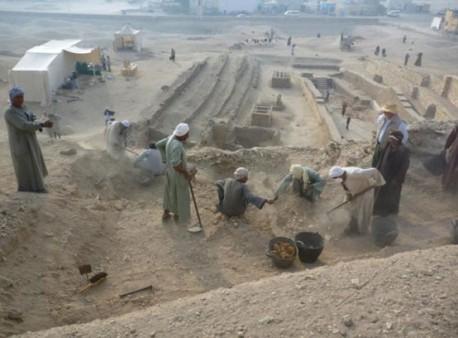Alan Boyle
Source - http://www.nbcnews.com/science/science-news/4-000-year-old-royal-tomb-unearthed-egypt-n126696

Archaeologists conducting an excavation at Dra Abu el-Naga necropolis. Photograph: CSIC
Spanish archaeologists say they have unearthed a 4,000-year-old tomb littered with human remains in the Egyptian city of Luxor, from a time when pharaohs reunified ancient Egypt.
A 65-foot-long (20-meter-long) hallway runs underground to a square burial chamber, the archaeologists said.
"The dimensions are considerable, leaving no doubt that the tomb belonged to a member of the royal family or a senior courtier," according to a news release issued Monday by Jose Galan, leader of the Djehuty Project excavation.

An entrance leads to a pharaonic tomb discovered in Luxor by Spanish archaeologists.
Galan said the tomb in the Dra Abu Naga necropolis dates back to the 11th Dynasty, roughly 2125 to 1991 B.C. During that time period, Upper and Lower Egypt were united under pharaonic rule from the ancient city of Thebes, which has given way to modern-day Luxor. Studying the tomb and its contents could provide fresh insights into the era.
The circumstances surrounding the remains found in the tomb are unclear. The AFP news service quoted an official from Egypt's antiquities ministry, Ali al-Asfar, as speculating that the tomb may have been used at some point as a mass grave or a cache for bodies. The archaeologists noted that the tomb contained pottery dating to Egypt's 17th Dynasty, about 400 years later, which suggests it was reused at that time.
The Djehuty Project has made previous finds in the same area, dating back to the 17th Dynasty as well as the 11th Dynasty. In 2008, Galan's team found an 11th-Dynasty tomb that contained a well-preserved red coffin and the mummy of a man named Iqer. Bows and arrows were placed nearby, suggesting that Iqer might have been a warrior.

Human remains litter the floor of the 4,000-year-old tomb's inner chamber.